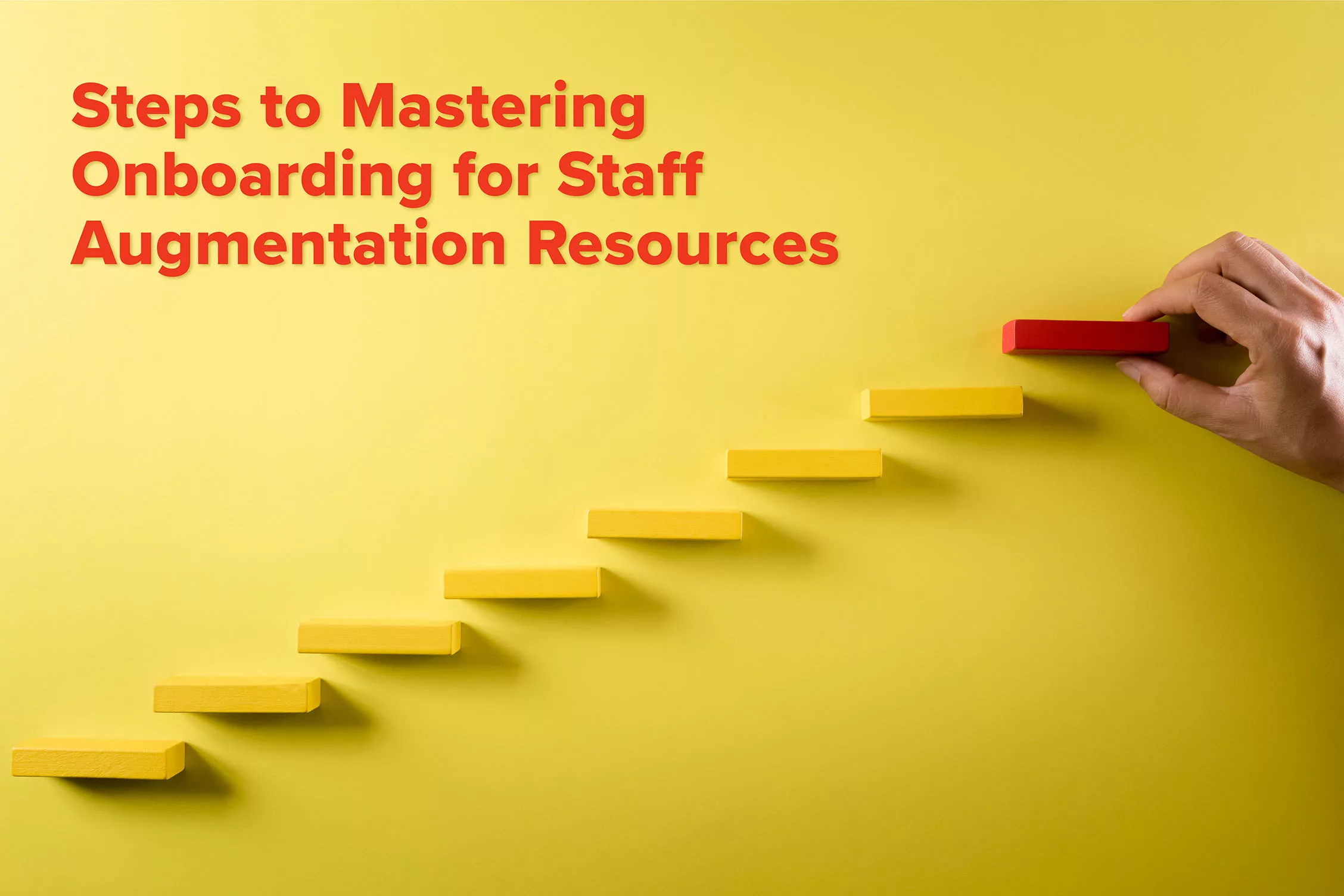Navigating the ever-changing world of business, companies frequently encounter challenges that demand specialized skills for particular projects. Yet, keeping a full-time staff for every skill needed can be a pricey and unwieldy task. That’s where staff augmentation steps in.
Staff augmentation is like adding extra players to your team– it’s about bringing in external talent to enhance the productivity of the existing team with greater efficiency. But here’s the catch: the success of staff augmentation largely depends on how smoothly these outsourced employees are integrated into the company’s workflow. In this blog post, we’ll dive into the art of mastering the onboarding process for staff augmentation resources.
Understanding Staff Augmentation

Before we get into the details of bringing more team members onboard through staff augmentation, let’s see what staff augmentation really is. It is like bringing in skilled professionals for a temporary period of time to get your tasks done. These professionals can be a diverse mix that includes: software developers, designers, project managers, or data analysts—tailored to suit the unique needs of a project.
Undoubtedly staff augmentation has been very successful. It grants organizations the power to access specialized skills without committing to lengthy contracts or the costs associated with hiring full-time staff. This approach adds a dose of scalability, allowing companies to swiftly adjust their workforce size as project requirements evolve. Moreover, it cultivates a culture of knowledge exchange, as augmented staff inject fresh perspectives and best practices gleaned from their diverse experiences.
Does Staff Augmentation Need Appropriate Employee Onboarding
Certainly, even when it’s a staff augmentation setup, nailing the onboarding process is key. Staff augmentation brings in outside experts to handle specific projects or fill skill gaps. Although these external experts might not be long-term fixtures, acing the onboarding is crucial for a few important reasons:
Grasping the Project: Onboarding is the golden opportunity to get the augmented staff up to speed on the project’s nitty-gritty—its goals, objectives, scope, and the big picture. It helps them understand where they fit in and how their work contributes to the overall scheme of things.
Embracing Company Culture and Values: A crash course in the company’s culture, values, and norms helps the augmented staff align their work style with the organization’s vibe. This alignment paves the way for smoother collaboration and integration with the internal team.
Building Team Bonds: Onboarding serves as the icebreaker, allowing the augmented staff to familiarize themselves with the internal team they’ll be working alongside. This sets the stage for effective communication, teamwork, and a sense of camaraderie, even if the collaboration is temporary.
The Importance of Effective Onboarding
Setting the stage for a fruitful collaboration begins with a well-executed onboarding process, especially when integrating extra hands into your existing teams through staff augmentation. It’s the bedrock that shapes the relationship, clarifies expectations, and ensures the added team members are ready to hit the ground running. Nevertheless, onboarding staff augmentation resources demands a slightly different game plan compared to bringing on permanent employees.
Tailoring the Onboarding Process
One-size-fits-all doesn’t cut it when it comes to onboarding staff augmentation resources. The process should be customized to match the unique needs of the project and the skills of the added staff. While some elements, like introducing company culture and values, may stay consistent, the technical aspects of onboarding need to sync up with the project’s requirements.
Clear Communication
Smooth onboarding relies on crystal-clear and steady communication. From the very beginning, the newly added team members should be equipped with all-encompassing details about the project’s aims, what’s expected, and the outcomes to be achieved. Keeping up with routine team gatherings and individual chats opens up avenues for transparent communication, making it a breeze for the new team members to ask questions and effortlessly update everyone on their progress.
Alignment with Company Culture
While staff augmentation may be a short-term gig, it’s crucial that those folks don’t feel like mere passersby. Offering them a peek into the company’s culture, mission, and values goes a long way in making them feel like they truly belong and are committed. When these temporary team members align with the company’s ethos, it sets the stage for better teamwork and a noticeable uptick in the quality of work they produce.
Steps to Mastering Onboarding for Staff Augmentation Resources

1. Preparation and Planning
Setting the stage for a successful onboarding journey goes way beyond the new team member’s first day. It’s all about laying the groundwork with careful preparation and planning. This means getting crystal clear on the project’s scope, sorting out roles and responsibilities, and pinpointing the skills needed for the job.
Clearly Outline Project Objectives
Start by mapping out the project’s goals, tasks, and expected results. This serves as the roadmap for what the augmented staff will be diving into.
Define Roles and Responsibilities
Avoid any confusion or gaps in work by spelling out who does what. Establish clear roles and responsibilities for both the augmented staff and existing team members.
Assess Skills Needed
Pin down the specific skills required for the project. This assessment ensures you bring in augmented staff members with the right expertise to meet the project’s demands.
2. Customized Onboarding Plan
Once you’ve nailed down the project’s needs, it’s time to whip up a tailor-made onboarding plan for the new team members and align it with their skills and what the project demands.
Get the Tech Gear Ready
Make sure they have all the hardware, software, and access rights they need right out of the gate. Technical hiccups can throw a wrench into productivity from day one, so let’s avoid those.
Show them the Ropes
Let’s familiarize our new additions with how things run around here. From workflows to tools and methodologies, we want them feeling like part of the gang. This not only cuts down on the time it takes to get up to speed but also gets them productive faster.
Dive into the Project
Give them the lowdown on the project – the goals, the challenges, and the key milestones. This deep dive helps our new folks grasp the big picture, understanding why their role matters in the grand scheme of things. Let’s set the stage for success!
3. Integration and Relationship Building
While augmented staff might be temporary, integration into the team is crucial for collaboration and project success.
Team Introductions
Facilitate introductions between augmented staff and the existing team members. This could include virtual meet-and-greets or team-building activities.
Buddy System
Assign a mentor or a “buddy” from the existing team to guide the augmented staff. This person can provide insights, answer questions, and offer support.
Regular Check-ins
Schedule regular check-in meetings to discuss progress, address challenges, and provide feedback. These meetings maintain alignment and ensure that the project is on track.
4. Access to Resources
Smooth onboarding requires easy access to resources, both human and informational.
Subject Matter Experts
Identify and introduce augmented staff to subject matter experts within the organization. These experts can provide insights and guidance on specific project-related queries.
Knowledge Repositories
Provide access to documentation, guidelines, and repositories that hold relevant information. This empowers augmented staff to find solutions independently.
Training Opportunities
Offer training sessions or workshops to enhance the skills of the augmented staff, especially if there are gaps between their existing skill set and the project’s requirements.
5. Continuous Feedback and Improvement
The onboarding process shouldn’t end after the initial orientation. Continuous feedback and improvement are essential for maximizing the value of augmented staff.
Feedback Loops
Establish feedback loops where augmented staff can share their thoughts on the onboarding process. Their insights can lead to process enhancements.
Performance Evaluation
Regularly assess the performance of augmented staff in alignment with project goals. Provide constructive feedback to help them grow and contribute effectively.
Benefits of Onboarding Staff Augmentation Resources Over Traditional Hiring

Flexibility
Easily adjust your workforce size based on project needs or sudden business shifts. This is especially handy for businesses dealing with varying workloads or short-term projects.
Cost-Efficiency
Traditional hiring comes with hefty costs – recruitment, training, benefits, and overhead. Staff augmentation often lets you find skilled professionals who are already trained, requiring minimal onboarding and slashing those initial expenses.
Specialized Expertise
When a project demands specific skills, staff augmentation lets you bring in professionals with exactly the expertise you need. This can save time and resources compared to training your existing team or hiring full-time staff.
Faster Time-to-Fill
Traditional hiring can be a lengthy process, involving job postings, interviews, and background checks. Staff augmentation significantly cuts down the time it takes to fill positions, allowing you to kick off projects sooner.
Reduced Long-Term Commitment
Hiring full-time employees means committing for the long haul, which might not suit short-term projects or uncertain business conditions. Staff augmentation allows you to bring in resources for the duration of a project without any long-term obligations.
Global Talent Pool
With staff augmentation, you can tap into a global talent pool. This opens doors to diverse skills, perspectives, and experiences that might not be readily available locally. It’s a game-changer for accessing a broad range of talents.
Pitfalls to Avoid

While mastering the art of onboarding staff augmentation resources, it’s essential to steer clear of common pitfalls that can hinder the process.
- Lack of Clarity: Unclear project goals, roles, or responsibilities can lead to confusion and misalignment. Ensure that everyone understands their contributions.
- Isolation: Failing to integrate augmented staff into the team can result in feelings of isolation. Foster a collaborative environment to promote effective teamwork.
- Neglecting Feedback: Feedback from augmented staff is invaluable for refining the onboarding process. Act on their suggestions to enhance the experience for future collaborations.
- Micromanagement: While guidance is essential, micromanaging augmented staff can stifle their creativity and hinder their productivity. Strike a balance between support and autonomy.
Conclusion
In the hustle and bustle of the business world, staff augmentation has become a game-changer, offering a smart way to tap into specialized skills without locking into long-term commitments. But here’s the real kicker—the key to making this strategy a hit lies in how smoothly you bring these talents into the fold. See, becoming a pro at onboarding staff augmentation resources isn’t just about getting individuals on board; it’s about something more profound.



